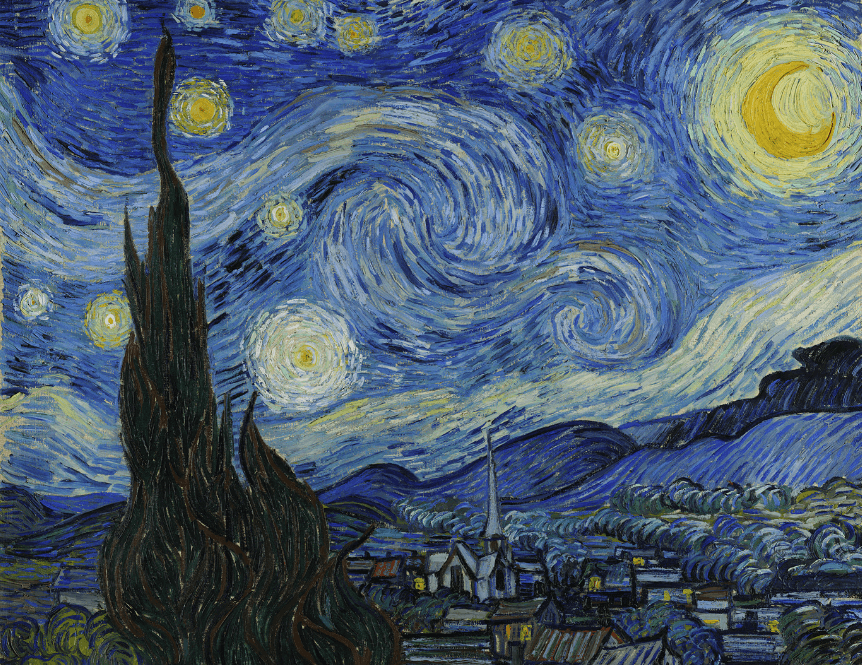A Sunday Afternoon on the Island of La Grande-Jatte – Georges Seurat

Artist: Georges Seurat
Date: 1886
Where to see it: Art Institute of Chicago, U.S.
“A Sunday Afternoon on the Island of La Grande Jatte” by Georges Seurat is one of the most important works of Post-Impressionism and considered a milestone of late 19th century art. The work depicts people from different social classes strolling and relaxing in a suburban park on an island in the Seine River called La Grande Jatte. Seurat was interested in exploring themes of modernity and social hierarchy in Parisian society. In the painting, Seurat meticulously incorporated his innovative technique known as Pointillism, which involves applying small, distinct dots of color to create a cohesive image when viewed from a distance.
The Starry Night – Vincent van Gogh

Artist: Vincent van Gogh
Date: 1889
Where to see it: Museum of Modern Art , New York
“The Starry Night” is Vincent van Gogh’s most widely recognized work and stands as one of the most acclaimed pieces in modern art history. Van Gogh, who struggled with mental illness, painted this masterpiece during his stay at the Saint-Paul asylum in Saint-Rémy-de-Provence, depicting the night view outside the window of his room.
Van Gogh aimed to depict his thoughts, emotions, and connection with nature through the vibrant colors of blues and yellows, along with swirling clouds, stars and the landscape. Although “The Starry Night” didn’t receive much attention during van Gogh’s lifetime, it gained global recognition after his death and has since been reinterpreted in various artistic fields such as pop art and music.
The Card Players – Paul Cézanne

Artist: Paul Cezanne
Date: 1890~1895
“The Card Players” is a series of oil paintings by the renowned French post-Impressionist, Paul Cézanne. Painted during Cézanne’s final artistic phase in the early 1890s, the series encompasses five distinct paintings. These artworks portray different versions of men engaged in a game of cards. The versions vary in size, the number of players, and the depicted setting.
The Royal Family of Qatar bought the last version of this famous series for $250 million in 2011. And the remaining pieces are housed in prominent institutions such as the Barnes Foundation Museum in Philadelphia, the Metropolitan Museum of Art in New York, Courtauld Institute in London and the Musée d’Orsay in Paris.
Where Do We Come From? What Are We? Where Are We Going? – Paul Gauguin

Artist: Paul Gauguin
Date: 1897~1898
Where to see it: Museum of Fine Arts, Boston, U.S.
“Where Do We Come From? What Are We? Where Are We Going?” is a monumental artwork by French artist Paul Gauguin, one of the leading figures of the Post-Impressionist art movement. Divided into three sections, the painting explores life’s existential questions. Gauguin indicated that the painting should be read from right to left, with the three major figure groups suggesting the cycle of “birth-sin-death”.
The first part depicts infancy and innocence, with a baby surrounded by Tahitian women in a lush landscape. The central section portrays adulthood and societal complexities, with figures engaged in various activities. The final part represents old age and contemplation, symbolizing the approach of death and the mysteries of the afterlife. Overall, it reflects Gauguin’s desire to delve into fundamental questions about existence and our place in the universe.
Au Moulin Rouge – Henri de Toulouse-Lautrec

Artist: Henri de Toulouse-Lautrec
Date: 1892~1895
Where to see it: Art Institute of Chicago, U.S.
“Au Moulin Rouge” is a key work in the oeuvre of Henri de Toulouse-Lautrec, one of the foremost representatives of the Post-Impressionist movement. Completed between 1892 and 1895, the painting captures the essence of Parisian nightlife at the iconic Moulin Rouge cabaret. Through bold colors, dynamic brushwork, and exaggerated forms, Toulouse-Lautrec portrays the vibrant atmosphere and lively characters of the cabaret scene. This work departs from strict realism, focusing instead on subjective interpretation and emotional expression. “Au Moulin Rouge” encapsulates the energy, excitement, and hedonism of Belle Époque Paris, providing a glimpse into the bohemian culture of the time. It remains a celebrated work of art, admired for its vivid portrayal of a moment in history and its significant contribution to the Post-Impressionist movement.
